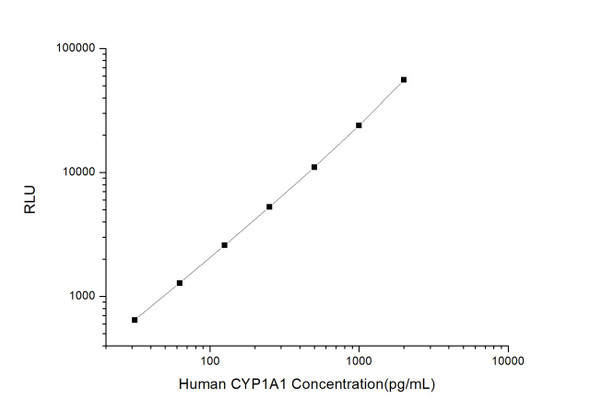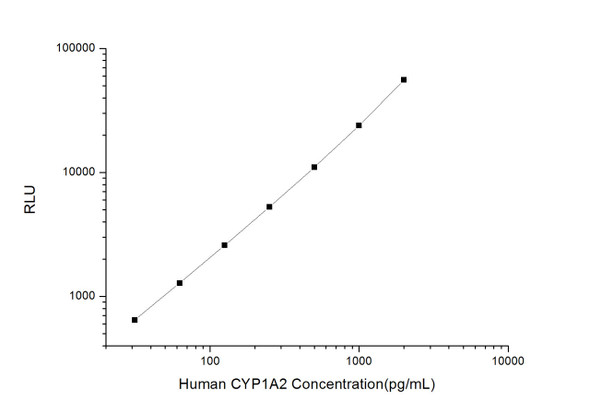Human Cell Biology ELISA Kits 3
Human CYP24A1 (Cytochrome P450, family 24, subfamily A, polypeptide 1) CLIA Kit (HUES00271)
- SKU:
- HUES00271
- Product Type:
- ELISA Kit
- ELISA Type:
- CLIA Kit
- Size:
- 96 Assays
- Sensitivity:
- 18.75pg/mL
- Range:
- 31.25-2000pg/mL
- ELISA Type:
- Sandwich
- Synonyms:
- CP24, CYP24, HCAI, P450-CC24, 1,25-dihydroxyvitamin D3 24-hydroxylase, mitochondrial
- Reactivity:
- Human
- Sample Type:
- Serum, plasma and other biological fluids
- Research Area:
- Cell Biology
Description
| Assay type: | Sandwich |
| Format: | 96T |
| Assay time: | 4.5h |
| Reactivity: | Human |
| Detection method: | Chemiluminescence |
| Detection range: | 31.25-2000 pg/mL |
| Sensitivity: | 18.75 pg/mL |
| Sample volume: | 100µL |
| Sample type: | Tissue homogenates,cell lysates and other biological fluids |
| Repeatability: | CV < 15% |
| Specificity: | This kit recognizes Human CYP24A1 in samples. No significant cross-reactivity or interference between Human CYP24A1 and analogues was observed. |
This kit uses Sandwich-CLIA as the method. The micro CLIA plate provided in this kit has been pre-coated with an antibody specific to Human CYP24A1. Standards or samples are added to the appropriate micro CLIA plate wells and combined with the specific antibody. Then a biotinylated detection antibody specific for Human CYP24A1 and Avidin-Horseradish Peroxidase (HRP) conjugate are added to each micro plate well successively and incubated. Free components are washed away. The substrate solution is added to each well. Only those wells that contain Human CYP24A1, biotinylated detection antibody and Avidin-HRP conjugate will appear fluorescence. The Relative light unit (RLU) value is measured spectrophotometrically by the Chemiluminescence immunoassay analyzer. The RLU value is positively associated with the concentration of Human CYP24A1. The concentration of Human CYP24A1 in the samples can be calculated by comparing the RLU of the samples to the standard curve.
| UniProt Protein Function: | CYP24A1: Has a role in maintaining calcium homeostasis. Catalyzes the NADPH-dependent 24-hydroxylation of calcidiol (25- hydroxyvitamin D(3)) and calcitriol (1-alpha,25-dihydroxyvitamin D(3)). The enzyme can perform up to 6 rounds of hydroxylation of calcitriol leading to calcitroic acid. It also shows 23- hydroxylating activity leading to 1-alpha,25-dihydroxyvitamin D(3)-26,23-lactone as end product. Defects in CYP24A1 are the cause of hypercalcemia infantile (HCAI). HCAI is a disorder characterized by abnormally high level of calcium in the blood, failure to thrive, vomiting, dehydration, and nephrocalcinosis. Belongs to the cytochrome P450 family. 2 isoforms of the human protein are produced by alternative splicing. |
| UniProt Protein Details: | Protein type:EC 1. 14. 13. 126; Mitochondrial; Oxidoreductase Chromosomal Location of Human Ortholog: 20q13 Cellular Component: mitochondrial inner membrane Molecular Function:iron ion binding; heme binding; 25-hydroxycholecalciferol-24-hydroxylase activity; oxidoreductase activity; 1-alpha,25-dihydroxyvitamin D3 (1,25-(OH)2D3) 24-hydroxylase activity Biological Process: osteoblast differentiation; steroid metabolic process; response to vitamin D; vitamin metabolic process; xenobiotic metabolic process; vitamin D metabolic process; vitamin D catabolic process Disease: Hypercalcemia, Infantile |
| NCBI Summary: | This gene encodes a member of the cytochrome P450 superfamily of enzymes. The cytochrome P450 proteins are monooxygenases which catalyze many reactions involved in drug metabolism and synthesis of cholesterol, steroids and other lipids. This mitochondrial protein initiates the degradation of 1,25-dihydroxyvitamin D3, the physiologically active form of vitamin D3, by hydroxylation of the side chain. In regulating the level of vitamin D3, this enzyme plays a role in calcium homeostasis and the vitamin D endocrine system. Alternatively spliced transcript variants encoding different isoforms have been found for this gene. [provided by RefSeq, Jul 2008] |
| UniProt Code: | Q07973 |
| NCBI GenInfo Identifier: | 19862747 |
| NCBI Gene ID: | 1591 |
| NCBI Accession: | Q07973. 2 |
| UniProt Secondary Accession: | Q07973,Q15807, Q32ML3, Q5I2W7, |
| UniProt Related Accession: | Q07973 |
| Molecular Weight: | 59kDa |
| NCBI Full Name: | 1,25-dihydroxyvitamin D(3) 24-hydroxylase, mitochondrial |
| NCBI Synonym Full Names: | cytochrome P450, family 24, subfamily A, polypeptide 1 |
| NCBI Official Symbol: | CYP24A1 |
| NCBI Official Synonym Symbols: | CP24; HCAI; CYP24; P450-CC24 |
| NCBI Protein Information: | 1,25-dihydroxyvitamin D(3) 24-hydroxylase, mitochondrial; 1,25-dihydroxyvitamin D(3) 24-hydroxylase, mitochondrial; 24-OHase; cytochrome P450 24A1; cytochrome P450-CC24; vitamin D 24-hydroxylase; exo-mitochondrial protein; vitamin D(3) 24-hydroxylase; 1,25-dihydroxyvitamin D3 24-hydroxylase; cytochrome P450, subfamily XXIV (vitamin D 24-hydroxylase) |
| UniProt Protein Name: | 1,25-dihydroxyvitamin D(3) 24-hydroxylase, mitochondrial |
| UniProt Synonym Protein Names: | Cytochrome P450 24A1; Cytochrome P450-CC24 |
| Protein Family: | 1,25-dihydroxyvitamin D(3) 24-hydroxylase |
| UniProt Gene Name: | CYP24A1 |
| UniProt Entry Name: | CP24A_HUMAN |
As the RLU values of the standard curve may vary according to the conditions of the actual assay performance (e. g. operator, pipetting technique, washing technique or temperature effects), the operator should establish a standard curve for each test. Typical standard curve and data is provided below for reference only.
| Concentration (pg/mL) | RLU | Average | Corrected |
| 2000 | 53199 58243 | 55721 | 55693 |
| 1000 | 21681 26267 | 23974 | 23946 |
| 500 | 11716 10348 | 11032 | 11004 |
| 250 | 4992 5596 | 5294 | 5266 |
| 125 | 2668 2548 | 2608 | 2580 |
| 62.5 | 1330 1292 | 1311 | 1283 |
| 31.25 | 637 711 | 674 | 646 |
| 0 | 27 29 | 28 | -- |
Precision
Intra-assay Precision (Precision within an assay): 3 samples with low, mid range and high level Human CYP24A1 were tested 20 times on one plate, respectively.
Inter-assay Precision (Precision between assays): 3 samples with low, mid range and high level Human CYP24A1 were tested on 3 different plates, 20 replicates in each plate.
| Intra-assay Precision | Inter-assay Precision | |||||
| Sample | 1 | 2 | 3 | 1 | 2 | 3 |
| n | 20 | 20 | 20 | 20 | 20 | 20 |
| Mean (pg/mL) | 105.39 | 206.82 | 902.96 | 96.54 | 197.55 | 857.08 |
| Standard deviation | 11.45 | 15.02 | 84.61 | 12.38 | 16.38 | 64.45 |
| C V (%) | 10.86 | 7.26 | 9.37 | 12.82 | 8.29 | 7.52 |
Recovery
The recovery of Human CYP24A1 spiked at three different levels in samples throughout the range of the assay was evaluated in various matrices.
| Sample Type | Range (%) | Average Recovery (%) |
| Serum (n=5) | 95-109 | 100 |
| EDTA plasma (n=5) | 89-101 | 94 |
| Cell culture media (n=5) | 98-111 | 105 |
Linearity
Samples were spiked with high concentrations of Human CYP24A1 and diluted with Reference Standard & Sample Diluent to produce samples with values within the range of the assay.
| Serum (n=5) | EDTA plasma (n=5) | Cell culture media (n=5) | ||
| 1:2 | Range (%) | 91-105 | 89-105 | 91-101 |
| Average (%) | 98 | 96 | 96 | |
| 1:4 | Range (%) | 87-98 | 88-101 | 95-109 |
| Average (%) | 93 | 95 | 102 | |
| 1:8 | Range (%) | 92-107 | 98-114 | 92-105 |
| Average (%) | 99 | 105 | 98 | |
| 1:16 | Range (%) | 86-98 | 101-118 | 93-104 |
| Average (%) | 92 | 109 | 99 |
An unopened kit can be stored at 4°C for 1 month. If the kit is not used within 1 month, store the items separately according to the following conditions once the kit is received.
| Item | Specifications | Storage |
| Micro CLIA Plate(Dismountable) | 8 wells ×12 strips | -20°C, 6 months |
| Reference Standard | 2 vials | |
| Concentrated Biotinylated Detection Ab (100×) | 1 vial, 120 µL | |
| Concentrated HRP Conjugate (100×) | 1 vial, 120 µL | -20°C(shading light), 6 months |
| Reference Standard & Sample Diluent | 1 vial, 20 mL | 4°C, 6 months |
| Biotinylated Detection Ab Diluent | 1 vial, 14 mL | |
| HRP Conjugate Diluent | 1 vial, 14 mL | |
| Concentrated Wash Buffer (25×) | 1 vial, 30 mL | |
| Substrate Reagent A | 1 vial, 5 mL | 4°C (shading light) |
| Substrate Reagent B | 1 vial, 5 mL | 4°C (shading light) |
| Plate Sealer | 5 pieces | |
| Product Description | 1 copy | |
| Certificate of Analysis | 1 copy |
- Set standard, test sample and control (zero) wells on the pre-coated plate and record theirpositions. It is recommended to measure each standard and sample in duplicate. Note: addall solutions to the bottom of the plate wells while avoiding contact with the well walls. Ensuresolutions do not foam when adding to the wells.
- Aliquot 100µl of standard solutions into the standard wells.
- Add 100µl of Sample / Standard dilution buffer into the control (zero) well.
- Add 100µl of properly diluted sample (serum, plasma, tissue homogenates and otherbiological fluids. ) into test sample wells.
- Cover the plate with the sealer provided in the kit and incubate for 90 min at 37°C.
- Aspirate the liquid from each well, do not wash. Immediately add 100µL of BiotinylatedDetection Ab working solution to each well. Cover the plate with a plate seal and gently mix. Incubate for 1 hour at 37°C.
- Aspirate or decant the solution from the plate and add 350µL of wash buffer to each welland incubate for 1-2 minutes at room temperature. Aspirate the solution from each well andclap the plate on absorbent filter paper to dry. Repeat this process 3 times. Note: a microplatewasher can be used in this step and other wash steps.
- Add 100µL of HRP Conjugate working solution to each well. Cover with a plate seal andincubate for 30 min at 37°C.
- Aspirate or decant the solution from each well. Repeat the wash process for five times asconducted in step 7.
- Add 100µL of Substrate mixture solution to each well. Cover with a new plate seal andincubate for no more than 5 min at 37°C. Protect the plate from light.
- Determine the RLU value of each well immediately.






